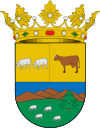Montenegro de Cameros
| Montenegro de Cameros municipality | ||
|---|---|---|
 Montenegro de Cameros - the site
|
||
| coat of arms | Map of Spain | |

|
|
|
| Basic data | ||
| Autonomous Community : |
|
|
| Province : | Soria | |
| Comarca : | Tierra de Cameros | |
| Coordinates | 42 ° 5 ′ N , 2 ° 45 ′ W | |
| Height : | 1225 msnm | |
| Area : | 55.32 km² | |
| Residents : | 57 (Jan. 1, 2019) | |
| Population density : | 1.03 inhabitants / km² | |
| Postal code : | 26127 | |
| Municipality number ( INE ): | 42121 | |
| administration | ||
| Website : | Montenegro de Cameros | |
Montenegro de Cameros is a small mountain village and a municipality ( municipio ) belonging to the populous Serranía Celtibérica with only 57 inhabitants (as of January 1, 2019) in the north of the Spanish province of Soria in the autonomous community of Castile-León .
Location and climate
The municipality of Montenegro de Cameros forms a - geographically more to the catchment area (cuenca) of the Ebro and thus to the autonomous region of La Rioja - tip in the extreme north of the province of Soria. The place of the same name is located on the edge of a hill above the Río Mayor at an altitude of approx. 1225 m . The distance to the provincial capital Soria is about 63 km in a southeast direction. The climate is temperate to warm; Rain (approx. 665 mm / year) falls mainly in the winter half-year.
Population development
| year | 1857 | 1900 | 1950 | 2000 | 2018 |
| Residents | 323 | 415 | 314 | 113 | 57 |
As a result of the mechanization of agriculture , the abandonment of small farms and the resulting lower demand for labor, the population of the mountain town has declined significantly since the middle of the 20th century ( rural exodus ).
economy
With the exception of barley , hardly any grain was possible to grow on the barren soils of the cold plateaus of the Soria province . For centuries the population lived mainly from breeding sheep and goats, from whose milk cheese was made, which after laborious transport could be sold at the market in Soria or in the nearby Ebro Valley or exchanged for flour, etc. The wool of the sheep was spun and woven into sheets of fabric during the winter months from which simple clothing was made. Goat hair was only suitable for making weatherproof throws (ponchos) or sacks, ropes, etc.
history
Celtiberian , Roman , Visigoth and even Islamic-Moorish traces of settlement were not discovered in the municipality. The high-lying area served as summer pasture for sheep and goats for centuries . A military reconquest ( reconquista ) by the Christians did not take place, but the place was gradually settled as part of the Repoblación . Since about 1040 the area belonged to the Navarre King García Sánchez III. created manor (señorio) of the Tierra de Cameros . In the further course of the Middle Ages, the region was at times disputed between the kingdoms of Castile and Navarre ; In 1366, Henry of Trastamara bequeathed 40 villages, including Montenegro, to Juan Ramírez de Arellano, whose descendants, the Condes de Águilar and the Duques de Abrantes, remained landlords (señores) of the area for a long time . After the abolition of the manorial system in 1811, the Cameros area belonged to the Soria Province and remained there - even after the Logroño Province was rebuilt in 1833.
Attractions
- With the exception of the buttresses , the single-nave and almost windowless church of the village (Iglesia de la Asunción) , built entirely from field stones , is dedicated to the Assumption of Mary . It has the entrance on the south side and a flat end of the choir with a round tracery window . In the star-vaulted interior is a worth seeing is altarpiece (retablo) with panel paintings from the early 16th century.
- According to some researchers , the Ermita San Mamés , which is partly Romanesque , but in its current state largely dates from the mid-16th century, is dedicated to St. Mamas of Cappadocia and is located on a hill about 500 m outside the village. The slightly pointed at the apex Gothic portal leads into the nave (nave) , in which are preserved some Gothic frescoes residues.
- The entire municipality is designated as a bird sanctuary .
Web links
- Montenegro de Cameros - Photos + Info (Spanish)
- Montenegro de Cameros - Photos + Info (Spanish)
- Montenegro de Cameros, sights - photos + information (arteguias, Spanish)
- Montenegro de Cameros - Photos + Quick Facts (Spanish)
Individual evidence
- ↑ Cifras oficiales de población resultantes de la revisión del Padrón municipal a 1 de enero . Population statistics from the Instituto Nacional de Estadística (population update).
- ↑ Montenegro de Cameros - climate tables
- ^ Montenegro de Cameros - population development
- ↑ Montenegro de Cameros - Church
- ↑ Montenegro de Cameros - Ermita

